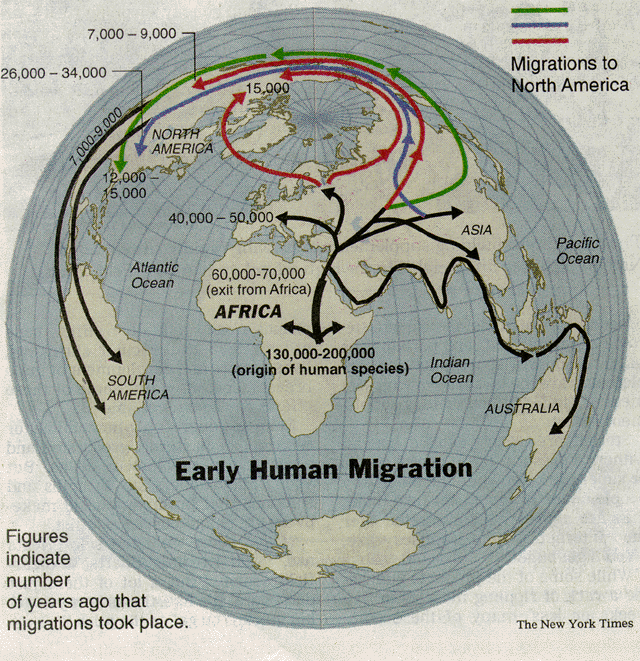|
Tracking the Movements of Early Humans
By Nicholas Wade
The New York Times 1-2 december 2002
COLD SPRING HARBOR, New York - Through the wizardry
of modern genetics, it is possible to reconstruct the travels of
the earliest humans as they moved out from their ancestral home
in northeast Africa and spread around the globe. More details of
these historic itineraries emerge each year, many at an annual conference
of population geneticists and archaeologists at the Cold Spring
Harbor Laboratory on Long Island in New York.
Geneticists can track these emigrations because of the train of
errors that slowly accumulates in certain regions of the DNA. After
a population splits, the people who go east will accumulate a different
set of errors from those who venture West.

From the population splits implied by these error patterns, geneticists
can reconstruct family trees of different lineages in the grand
genealogy of humankind, and even assign rough dates to the branch
points.
At this year's conference, which ended recently, Dr. Peter Underhill
of Stanford University in California showed how scholars could begin
to link the data in the genome's archive with historical events.
Anatolia, the ancient name for Turkey, bas long been a corridor
for armies and peoples traveling between Europe and Asia.
Dr. Underhill bas been analyzing the various Y chromosome lineages
present in today's Turkish population. He has found one lineage
whose ancestors may have carried the agricultural revolution from
Anatolia to Europe during the Neolithic era, 8,000 to 3,000 years
ago. Anatolians with another Meage may be descendants of the Bronze
Age Hattic culture, he said. Curiously the Seljuk Turks, who wrested
Anatolia from the Byzantine Empire in the llth century, left only
a faint genetic signal of their presence, Dr. Underhill said. Though
the conquerors imposed their culture over a wide region, an army
of 40,000 made little genetic difference to a population that had
reached 12 million by Roman times.
Most of the evidence suggests there was only one emigration of modern
humans from Africa, a small group that left some 40,000 to 50,000
years ago an populated first Asia and then Europe. But some geneticists
think there may have been an earlier exodus of people whd traveled
by boat along the south ern'Asian coasts, eventually reaching Australia.
The people of Australia and Papua New Guinea are dark skinned and
somewhat different from most other Asians and Europeans.
To test the idea of a southern route, Dr. James F. Wilson of University
College London compared the DNA of the dark skinned aboriginal tribes
of southern India with that of New Guinea highlanders to see if
the two might be part of the same exodus. The first gene he looked
at suggested they were related, but further study showed otherwise.
"The distinctiveness of New Guineans could be from long-term
drift, not a different route out of Africa," he said. Drift
is the geneticist's terra for the random change that takes place
between generations as some genetic variants become more common
and others get rarer or disappear.
UNIVERSITAIRE
| CONSULTANT | EXPERT
| RETOUR ACCUEIL
CLEFS PUBLIQUES PGP |
REIGNIER | DOMAINE
PRIVE
Copyright © 1997-2002 Paul
Vidonne Consultant, All Rights Reserved.
Empreinte : 7E7C 87DE 2741 9B4D C48A 185A 9D6A CF76 75BF C09D
|